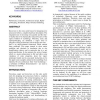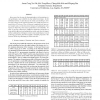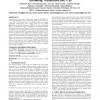305 search results - page 39 / 61 » On modeling top-down VLSI design |
ESM
2000
13 years 8 months ago
2000
Know-how is the most useful mean for designing new processors before a complete hardware description. The integration rate is increasing very quickly and the timeto-market has to ...
TCAD
2010
13 years 2 months ago
2010
Design debugging is a major bottleneck in modern VLSI design flows as both the design size and the length of the error trace contribute to its inherent complexity. With typical des...
ISPD
2005
ACM
14 years 1 months ago
2005
ACM
The sustained progress of VLSI technology has altered the landscape of routing which is a major physical design stage. For timing driven routings, traditional approaches which con...
ICCAD
1997
IEEE
13 years 11 months ago
1997
IEEE
Interconnect has become the dominating factor in determining circuit performance and reliability in deep submicron designs. In this embedded tutorial, we first discuss the trends...
ISLPED
2009
ACM
14 years 2 months ago
2009
ACM
The theoretical lower limit of subthreshold swing in MOSFETs (60 mV/decade) significantly restricts low voltage operation since it results in a low ON to OFF current ratio at low ...



